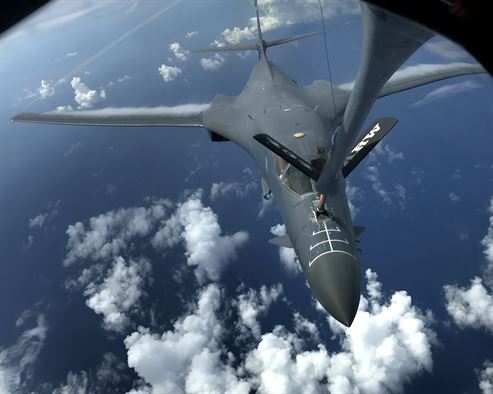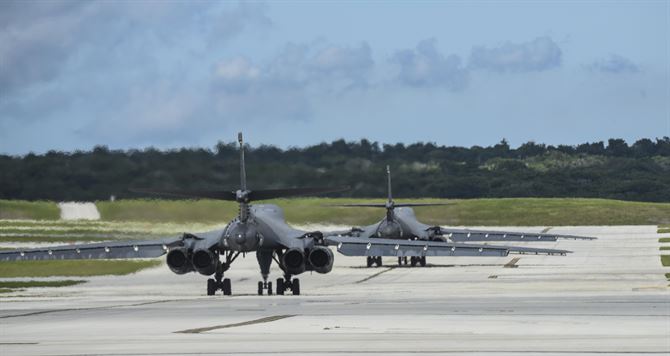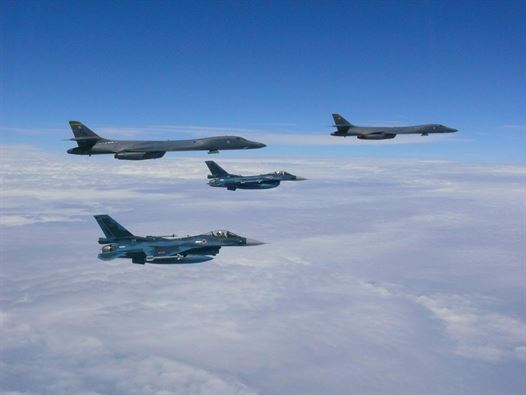North Korea is reviewing plans to strike U.S. military targets in Guam with its medium-range ballistic missiles to create “enveloping fire,” according to the state media Korean Central News Agency.
The message came hours after President Trump warned North Korea on Tuesday that it will be “met with fire and fury and frankly power, the likes of which this world has never seen before,” if it does not stop threatening the United States. The threats also follow a unanimous vote by the U.N. Security Council to impose strict new sanctions on North Korea.
That Kim Jong Un is eyeing Guam, the sovereign U.S. territory island with a strategic airfield and naval station, is no surprise to the 160,000 Guamanians there.
“Every time there is some saber rattling in the part of the world, Guam is always part of the occasion,” said Robert F. Underwood, the president of the University of Guam and the island’s former delegate to the House of Representatives.
“When you’re from Guam and live on Guam, it’s disconcerting, but not unusual,” he told The Washington Post.
Long a strategic linchpin
At about 4,000 miles west of Hawaii, and 2,200 miles southeast of North Korea, Guam is on the edge of U.S. power in the Pacific. Its combined Navy and Air Force installation, Joint Region Marianas, is the home port for nuclear submarines, a contingent of Special Operations Forces and the launching point of flights for strategic bombers conducting rotational flights over Japanese territories and in the Korean Peninsula.
Guam has been a strategic linchpin after Spain relinquished control to the U.S. Navy following the Spanish-American War in 1898. Japanese forces sped to the island following the bombing of Pearl Harbor in 1941 and captured it, subjecting its people to violence that some historians estimate to have killed 10 percent of its population.
The island just celebrated its 73rd Liberation Day, commemorating the start of the U.S.-led effort to liberate Guam on July 10, 1944, Underwood said.
Now the island paradise relies on tourism and military activity to buoy its economy, which is marked by high unemployment. There have been recent efforts to grant Guam more control over its government, including support from the United Nations. Guamanians have a delegate to the House of Representatives and cannot vote for president, but they do vote for party delegates in primaries.
A building military presence
A pair of B-1B Lancer bombers arrived in Guam from South Dakota this week to fly with South Korean and Japanese counterparts. That mission follows an operation over the Korean Peninsula in late July, in which the warplanes were scrambled from Guam as a response to North Korea’s second test of an intercontinental ballistic missile that experts said could have reached as far as New York.
Guam’s growing strategic importance is due to its sovereign status, Underwood said. The United States must get clearance from ally nations like South Korea and Japan to build up its military hardware in the event of defense escalations, which can be a lengthy process. But Guam has been used to project power immediately, Underwood said.
The island is also home to a terminal high-altitude area defense missile defense battery, which targets ballistic missiles. The presence of THAAD systems in South Korea has drawn consternation from Pyongyang and Beijing, which view the defensive system as an escalating presence.
It was unclear Tuesday whether the Pentagon had elevated the readiness posture of its Guam-based fleet of ships and planes following the threat from North Korea.
“We always maintain a high state of readiness and have the capabilities to counter any threat, to include those from North Korea,” Johnny Michael, a spokesman for Defense Secretary Jim Mattis, said in a statement provided to The Post.
The numerous installations on Guam host about 6,000 troops and growing as the United States seeks to rebalance its forces in the Pacific amid a growing reach of China's military and North Korea’s increasingly sophisticated nuclear program. In 2014, then-Deputy Defense Secretary Bob Work said 60 percent of the Navy and 60 percent of combat air forces would be located in the region.
“Guam has always been a central part of our plans. Certainly a central part of the Navy’s plans but now a central part of the entire Department of Defense’s plans,” he said.
Outsized contributions to the U.S.
That leaves an island of U.S. citizens watching the news closely as posturing escalates on either side of the Pacific.
“Most of the time the overheated rhetoric comes from North Korea. This time it’s coming from the U.S. side,” Underwood said.
Guamanians share two common sentiments about their role in foreign policy, Underwood said. Media reports focus on the importance of military installations, making locals feel like they are bit players on a large stage, he said. Others would rather shed the crosshairs.
“People say ‘I hate being a target. We’re the tip of the spear. Why can’t we be another part of the spear?’ ” Underwood said.
But Guam also has a proud tradition of supplying U.S. troops from its island, with a disproportionate number of recruits coming from there and American Samoa, Underwood said.
Eighteen Guamanian troops were killed in Iraq and Afghanistan, pointing to an outsized sacrifice for a territory with a population smaller than Eugene, Ore.
“We have more skin and more land in the game,” Underwood said.
185
Comments



